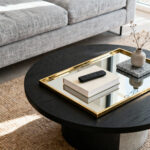As a passionate advocate for sustainable living, I’m constantly seeking ways to infuse my home with eco-friendly elements that not only reduce our environmental impact but also elevate the overall aesthetic. And what better place to start than the heart of the home – the kitchen? Whether you’re embarking on a full-scale renovation or simply looking to refresh your space, incorporating sustainable tile options can breathe new life into your culinary sanctuary while aligning with your values.
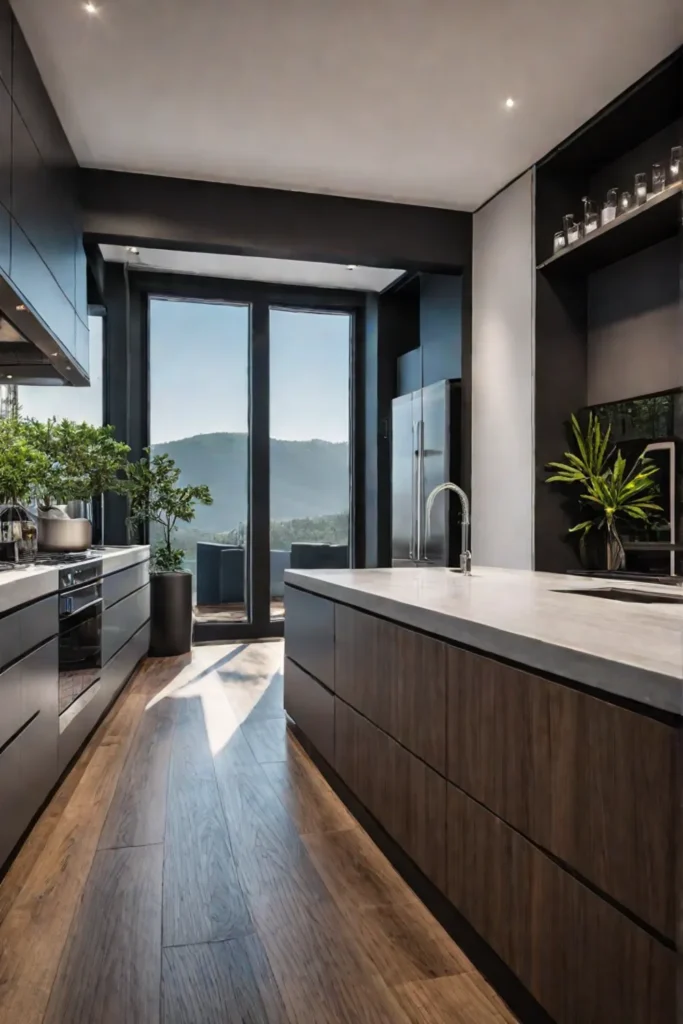
From the shimmering beauty of recycled glass tiles to the timeless charm of reclaimed terracotta, the possibilities for creating a truly eco-chic kitchen are endless. Join me on a journey through six captivating tile options that seamlessly blend sustainability, durability, and style – because in the world of design, going green has never looked so gorgeous.
Recycled Glass Tile: Shimmering Style with a Past
Sustainability and style converge beautifully in the form of recycled glass tile. These eye-catching tiles are crafted from post-consumer or pre-consumer recycled glass, giving them an eco-friendly edge that aligns perfectly with Portland’s environmentally conscious ethos.
The Recycling Process and its Environmental Benefits
The process of transforming discarded glass into stunning tiles is a testament to the power of upcycling. Bottles, jars, and even old windows are collected, crushed, and melted down to create a vibrant mosaic of colors and textures. By repurposing these materials, we reduce the demand for virgin resources and prevent additional waste from ending up in landfills.

Design Inspirations: From Backsplashes to Feature Walls
Recycled glass tile offers a world of possibilities for infusing your kitchen with character and charm. Imagine a vibrant backsplash that catches the eye with its shimmering hues, or a mosaic floor that tells a story with every step. These tiles can even be used to create stunning feature walls, transforming a mundane space into a conversation piece.
One of my favorite design tricks is to mix and match different shades and textures of recycled glass tile. The result is a one-of-a-kind masterpiece that reflects your unique style while paying homage to the environment. And let’s not forget the practical benefits – these tiles are durable, non-porous, and stain-resistant, making them a perfect choice for high-traffic areas like the kitchen.
Practical Tips:
- Create a statement backsplash by combining recycled glass tiles with sleek subway tiles for a modern twist.
- For a bold floor, try a mosaic pattern using a mix of recycled glass tiles in complementary hues.
- Incorporate recycled glass tile accents into your kitchen island or countertop for a pop of color and texture.

When it comes to sources of recycled glass, the options are endless. From discarded bottles and jars to old windows and even stained glass, each piece carries its own story and character. And while recycled glass tile may be slightly more expensive than traditional ceramic tile, the investment is well worth it for the unique beauty and eco-friendly credentials it brings to your home.
In the end, recycled glass tile is more than just a flooring or backsplash option – it’s a celebration of sustainability, creativity, and the beauty that can be found in the most unexpected places.
As we transition to exploring the rich history and charm of reclaimed tile, remember that every design choice we make has the power to create a more beautiful and sustainable world.
Reclaimed Tile: Unearthing History, One Tile at a Time
In our ever-evolving quest for sustainable living, reclaimed tiles have emerged as a captivating choice for the eco-conscious decorator. These tiles, salvaged from historic buildings and architectural remnants, offer a unique story that breathes life into your kitchen space.

Sourcing and Selecting Reclaimed Tile
Sourcing reclaimed tiles can be an adventure in itself. Explore local salvage yards, antique stores, or online marketplaces specializing in architectural salvage. Each tile carries a unique history, from the handcrafted terracotta tiles of a 19th-century hacienda to the intricate encaustic patterns of a Victorian-era estate.
As you browse through the treasures, keep an eye out for imperfections – the very character that adds charm to these timeworn tiles. Embrace the subtle variations in color, texture, and shape, for they are the fingerprints of artisans long gone, yet forever etched into these enduring pieces.
Installation Tips and Considerations for Older Materials
Working with reclaimed tiles requires a delicate touch and a keen eye for detail. Inspect each tile carefully for any damage or structural integrity issues before installation. Consider hiring a professional installer with experience in handling older materials, as their expertise can ensure a seamless integration of these historic gems into your modern kitchen.

When it comes to design, the possibilities are endless. Create a rustic farmhouse ambiance with reclaimed terracotta tiles, or add a touch of history with antique encaustic tiles as a floor accent. Regardless of your chosen style, these tiles will infuse your kitchen with a sense of timelessness and sustainability.
By embracing reclaimed tiles, you not only reduce waste and support historical preservation but also invite a piece of the past into your home. Each tile becomes a storyteller, weaving tales of the lives it has witnessed, and the journeys it has undertaken to grace your kitchen with its enduring beauty.
Natural Stone Tile: Timeless Elegance, Responsibly Sourced
When it comes to creating a timeless and luxurious look in your kitchen, few materials can match the beauty and durability of natural stone tiles. From the rich veining of marble to the rugged texture of slate, each piece is a unique work of art, adding depth and character to your space.

Sustainable Quarrying and Sourcing Practices
As an eco-conscious decorator, I always strive to source materials that are ethically and responsibly produced. Look for natural stone suppliers that follow sustainable quarrying practices, minimizing environmental impact and ensuring fair labor conditions. Certifications like the Rainforest Alliance and Fair Trade USA can help you identify responsibly sourced stone.
To reduce the carbon footprint associated with transporting heavy stone materials, consider sourcing from local or regional quarries whenever possible. Not only does this support your local economy, but it also cuts down on the emissions from long-distance shipping.
Choosing the Right Stone for Your Kitchen Needs
When selecting natural stone tiles for your kitchen, consider both aesthetic and practical factors. For a classic and opulent look, polished marble floors are hard to beat. However, marble can be prone to scratches and stains, so it may not be the best choice for high-traffic areas or households with young children or pets.
Granite, on the other hand, is incredibly durable and naturally antimicrobial, making it an excellent choice for kitchen floors and countertops. Its unique patterns and colors can add warmth and depth to your space.
For a more rustic and organic feel, consider textured slate tiles. Their natural variations in color and texture can create a cozy, earthy ambiance in your kitchen.
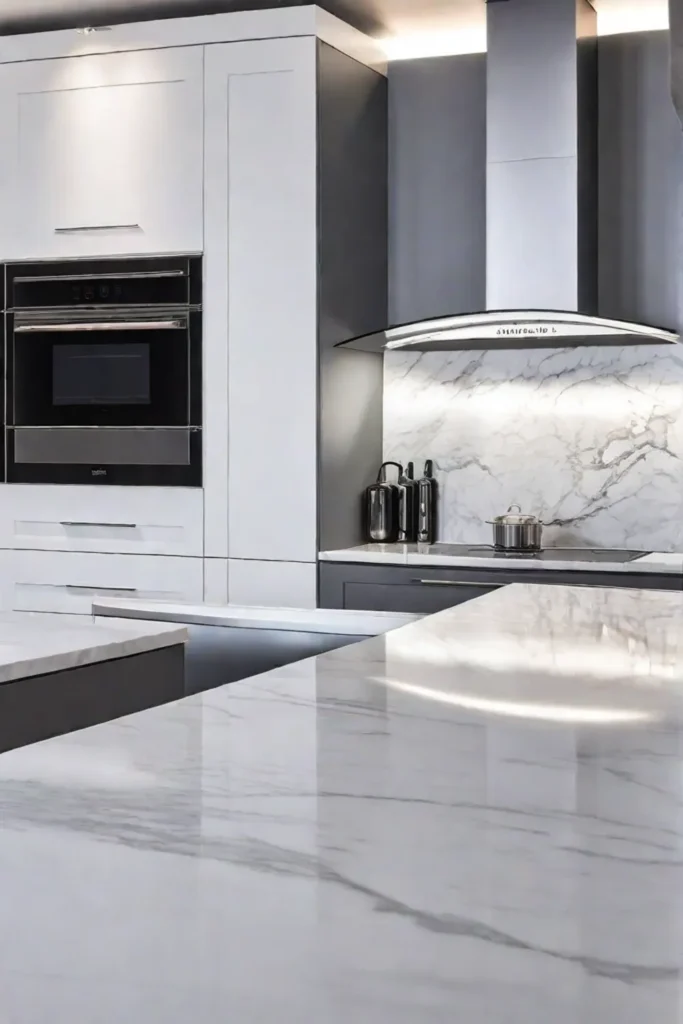
To complement your natural stone flooring, consider using the same material for countertops, backsplashes, or even accent walls. This creates a cohesive and harmonious design throughout your kitchen.
While natural stone can be a more expensive option upfront, its durability and timeless appeal can increase the value of your home in the long run. With proper sealing and maintenance, these tiles can last for decades, making them a worthwhile investment for the eco-conscious homeowner.
Remember, when it comes to natural stone, each piece is unique, and that’s what makes it so special. Embrace the subtle variations and imperfections, for they are the hallmarks of a truly one-of-a-kind and sustainable design.
Cork Flooring: Warmth, Comfort, and Sustainability Underfoot
Cork flooring is a true eco-warrior in the world of sustainable kitchen design. Harvested from the bark of the mighty cork oak trees, this renewable material offers a unique blend of comfort, durability, and natural beauty.

The Cork Harvesting Process and its Ecological Impact
One of the most remarkable aspects of cork is its sustainable harvesting process. The bark is carefully stripped from the trees every nine years, allowing the trees to regenerate and continue thriving for centuries. This gentle process ensures that no trees are harmed, making cork an incredibly eco-friendly choice.
Design Styles: From Traditional to Modern Aesthetics
Cork’s versatility extends beyond its environmental credentials. Its warm, earthy tones and unique texture lend themselves to a wide range of design styles, from rustic and traditional to sleek and modern. Whether you’re aiming for a cozy, inviting kitchen or a contemporary, minimalist space, cork can seamlessly integrate into your desired aesthetic.
Interestingly, cork flooring can also help reduce noise levels in your home, thanks to its natural insulating properties. This makes it an ideal choice for open-concept living spaces, where sound can easily travel from one room to another.
Practical Tips for a Stunning Cork Kitchen Floor
- Embrace the natural variations in cork’s texture and color to create a visually captivating space.
- Combine cork with other sustainable materials like bamboo or recycled glass for a truly eco-chic kitchen.
- Choose from a variety of colors and patterns to match your kitchen style, from classic shades to bold, statement-making hues.
- Use cork flooring in high-traffic areas like the kitchen for added comfort and warmth underfoot.

Durability and Maintenance
While cork may not be as durable as hardwood or tile, it can still withstand heavy foot traffic and daily wear and tear. With proper care and maintenance, such as regular sweeping and occasional resealing, cork flooring can last for decades.
To keep your cork floors looking their best, avoid harsh cleaners and opt for gentle, pH-neutral solutions. Additionally, place mats or rugs in high-traffic areas to prevent excessive wear and tear.
In the end, cork flooring provides a comfortable, eco-friendly, and visually stunning option for your kitchen, offering insulation, natural beauty, and a touch of warmth to your home’s heart.
As we explore the world of sustainable flooring options, let’s turn our attention to another rapidly renewable and endlessly versatile material: bamboo. In the next section, we’ll delve into the unique characteristics and design possibilities of bamboo flooring, a true embodiment of eco-chic living.
Bamboo Flooring: Rapidly Renewable and Endlessly Versatile
As a design enthusiast with a passion for sustainable living, I’m always on the lookout for eco-friendly materials that don’t compromise style or functionality. That’s why bamboo flooring has become one of my go-to choices for creating beautiful and environmentally-conscious spaces.

Types of Bamboo Flooring: Solid vs. Engineered
Bamboo flooring comes in two main varieties: solid and engineered. Solid bamboo planks are made from a single piece of bamboo, while engineered bamboo features a bamboo veneer top layer over a plywood or high-density fiberboard core. Both options offer unique advantages:
- Solid bamboo is ideal for those seeking a truly natural look and feel. It can be refinished multiple times, extending its lifespan.
- Engineered bamboo is more dimensionally stable, making it a great choice for areas with fluctuating humidity levels or radiant heating systems.
Sustainable Harvesting and Manufacturing Practices
One of the biggest draws of bamboo flooring is its rapid renewability. Bamboo is a grass that can grow up to 3 feet per day, making it one of the fastest-growing plants on Earth. This means it can be harvested and replenished much more quickly than traditional hardwood trees.
When sourcing bamboo flooring, look for products certified by organizations like the Forest Stewardship Council (FSC) or the Bamboo Flooring Certification Program (BFCP). These certifications ensure that the bamboo has been sustainably harvested and manufactured using environmentally friendly processes.

Versatile Style and Practical Benefits
Beyond its eco-friendly credentials, bamboo flooring offers a versatile range of styles and practical benefits:
- Natural bamboo has a light, airy feel that can brighten up any space.
- Dark-stained or horizontally-grained bamboo creates a modern, sleek aesthetic.
- Bamboo is highly durable and moisture-resistant, making it an excellent choice for kitchens and high-traffic areas.
- For a cohesive design, consider using bamboo flooring throughout your home.
When it comes to cost, bamboo flooring is generally comparable to traditional hardwood, with prices ranging from $3 to $8 per square foot, depending on the type and quality.
Bamboo flooring offers a beautiful and sustainable alternative to hardwood, combining style and durability with a rapidly renewable resource. As you embark on your kitchen renovation, consider this eco-chic option for a greener home that doesn’t compromise on design.
As we continue our exploration of sustainable kitchen tile ideas, our next section will delve into the world of recycled and reclaimed materials, showcasing how creativity and resourcefulness can lead to stunning and environmentally friendly designs.
Choosing the Right Eco-Friendly Flooring for Your Kitchen
As someone who’s always on the hunt for innovative and sustainable decor solutions, I can’t emphasize enough the importance of choosing the right eco-friendly flooring for your kitchen. Not only does it contribute to a healthier indoor environment, but it also aligns with your commitment to living a greener lifestyle.
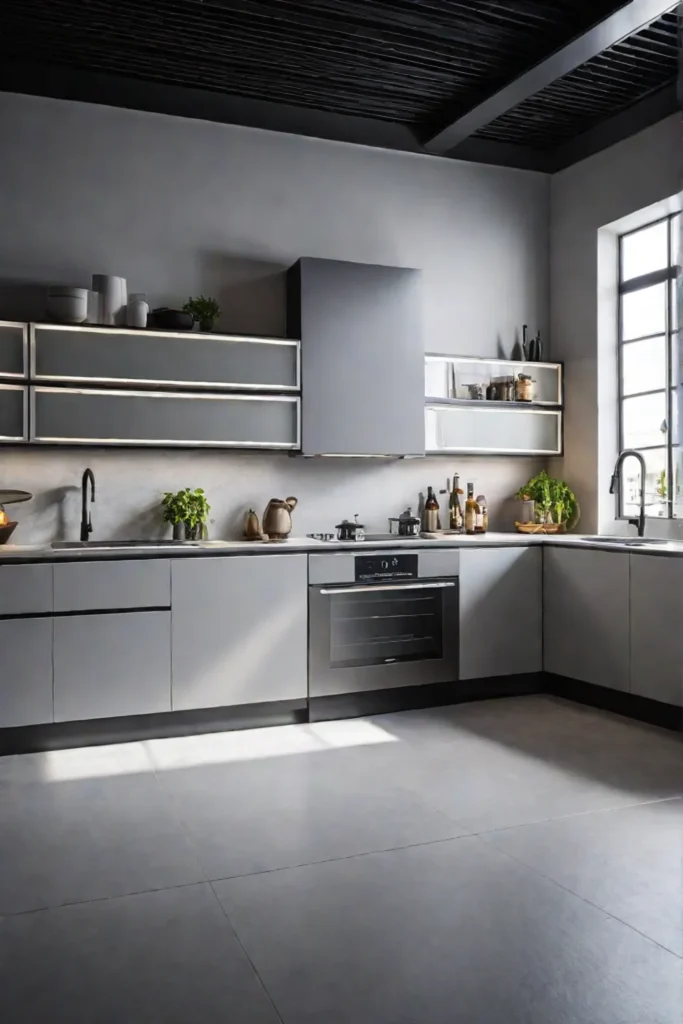
When it comes to selecting the perfect flooring, there are a few key factors to consider: durability, moisture resistance, and style. After all, your kitchen is a high-traffic area prone to spills and messes, so you’ll want a material that can withstand the wear and tear of daily life.
Factors to Consider: Durability, Moisture Resistance, and Style
Let’s start with durability. If you have an active household with kids or pets, you’ll want a flooring option that can handle the occasional scuff or scratch. Materials like bamboo, cork, and certain types of tile are known for their resilience and longevity.
Moisture resistance is another crucial factor, especially in the kitchen where spills and splashes are inevitable. Opt for materials that are naturally water-resistant or have a protective coating, such as ceramic or porcelain tiles, luxury vinyl planks, or engineered hardwood.
And, of course, we can’t forget about style! Eco-friendly flooring options come in a wide range of colors, textures, and patterns, so you’re sure to find something that complements your kitchen’s aesthetic. I’m a big fan of the warm, natural look of cork or the sleek, modern vibe of concrete tiles.
Certifications and Labels to Look for in Sustainable Flooring
When shopping for eco-friendly flooring, keep an eye out for certifications and labels that indicate the material’s sustainability credentials. The Forest Stewardship Council (FSC) certification ensures that wood products come from responsibly managed forests, while the Greenguard certification guarantees low chemical emissions for improved indoor air quality.

Remember, investing in eco-friendly materials not only benefits the environment but can also increase your home’s value in the long run. So, take the time to research manufacturers committed to sustainable practices and prioritize transparency in their sourcing and production methods.
One of the best ways to make an informed decision is to order samples of different materials and compare them side by side. Trust me, seeing and feeling the textures in person can make a world of difference in your selection process.
Don’t be afraid to consult with a flooring professional – their expertise can guide you through the installation process and provide valuable tips on proper maintenance to ensure your eco-friendly flooring lasts for years to come.
As you embark on your kitchen renovation journey, remember to consider the overall sustainability of the project. From energy-efficient appliances to eco-friendly cabinetry, every choice you make contributes to creating a greener, more sustainable home.
By choosing eco-friendly flooring options and making informed decisions, you can create a beautiful and sustainable kitchen that not only reflects your style but also aligns with your values and commitment to the environment.
Wrapping Up
As we bid farewell to this exploration of sustainable kitchen tile options, I can’t help but feel inspired by the boundless potential for marrying eco-consciousness with artistic expression. Each tile we’ve discussed – from the shimmering hues of recycled glass to the rugged texture of natural stone – tells a story of resourcefulness, creativity, and respect for our planet.
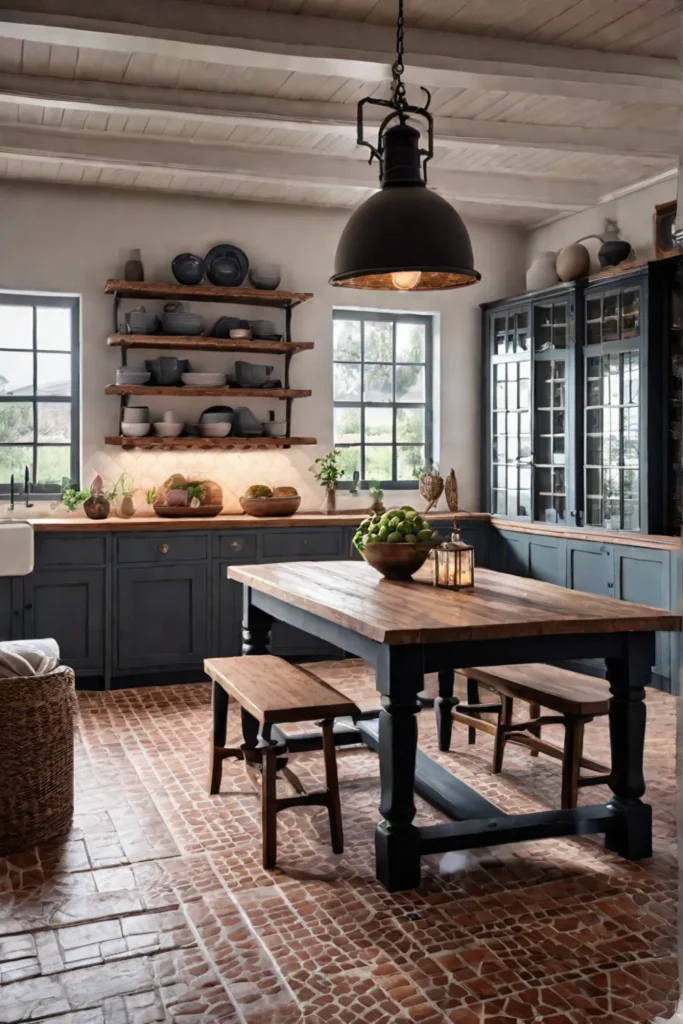
Remember, every design choice we make is an opportunity to create a more beautiful and sustainable world, one tile at a time. So, whether you’re drawn to the warmth of cork flooring, the timeless elegance of reclaimed tile, or the sleek modernity of bamboo, embrace the power of your choices and let your kitchen become a canvas for your eco-chic vision.
In the end, true beauty lies not only in the aesthetics but also in the mindful decisions that shape our living spaces. By prioritizing sustainability, we honor the earth’s resources while creating homes that radiate character, comfort, and a profound connection to the natural world around us.
So, let’s raise a glass (preferably one made from recycled materials) to a future where eco-friendly design is the norm, and our kitchens are not just functional spaces but also vibrant expressions of our commitment to a greener, more sustainable way of life.








